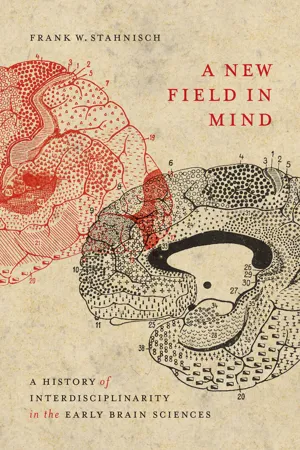
A New Field in Mind
A History of Interdisciplinarity in the Early Brain Sciences
- English
- ePUB (mobile friendly)
- Available on iOS & Android
About this book
In recent decades, developments in research technologies and therapeutic advances have generated immense public recognition for neuroscience. However, its origins as a field, often linked to partnerships and projects at various brain-focused research centres in the United States during the 1960s, can be traced much further back in time.In A New Field in Mind Frank Stahnisch documents and analyzes the antecedents of the modern neurosciences as an interdisciplinary field. Although postwar American research centres, such as Francis O. Schmitt's Neuroscience Research Program at MIT, brought the modern field to prominence, Stahnisch reveals the pioneering collaborations in the early brain sciences at centres in Germany, Austria, and Switzerland in the first half of the twentieth century. One of these, Heinrich Obersteiner's institute in Vienna, began its work in the 1880s. Through case studies and collective biographies, Stahnisch investigates the evolving relationships between disciplines – anatomy, neurology, psychiatry, physiology, serology, and neurosurgery – which created new epistemological and social contexts for brain research. He also shows how changing political conditions in Central Europe affected the development of the neurosciences, ultimately leading to the expulsion of many physicians and researchers under the Nazi regime and their migration to North America. An in-depth and innovative study, A New Field in Mind tracks the emergence and evolution of neuroscientific research from the late nineteenth century to the postwar period.
Frequently asked questions
- Essential is ideal for learners and professionals who enjoy exploring a wide range of subjects. Access the Essential Library with 800,000+ trusted titles and best-sellers across business, personal growth, and the humanities. Includes unlimited reading time and Standard Read Aloud voice.
- Complete: Perfect for advanced learners and researchers needing full, unrestricted access. Unlock 1.4M+ books across hundreds of subjects, including academic and specialized titles. The Complete Plan also includes advanced features like Premium Read Aloud and Research Assistant.
Please note we cannot support devices running on iOS 13 and Android 7 or earlier. Learn more about using the app.
Information
Table of contents
- Cover
- Copyright
- Contents
- Illustrations
- Preface
- Acknowledgments
- Abbreviations
- 1 Introduction
- 2 The Disciplinary Makeup of Clinical and Basic Research in Imperial Germany
- 3 Shortfalls of Individualized Research, the Emergence of Clinical Neurology, and the Demands of Modern Life, 1910s to 1930s
- 4 War, Trauma, Regeneration
- 5 The Later Weimar Period
- 6 The Machtergreifung of the National Socialists and Its Effects on the German-Speaking Neurosciences
- 7 On Cultural and Professional Contexts of Theory-Change in the Neurosciences Due to the Forced Migration Wave since 1933
- 8 “They Called Me an American Monkey Psychiatrist”
- 9 Conclusion: The Development of Interdisciplinary Work in the Neurosciences
- APPENDIX Graphic Representations
- Notes
- Bibliography
- Index